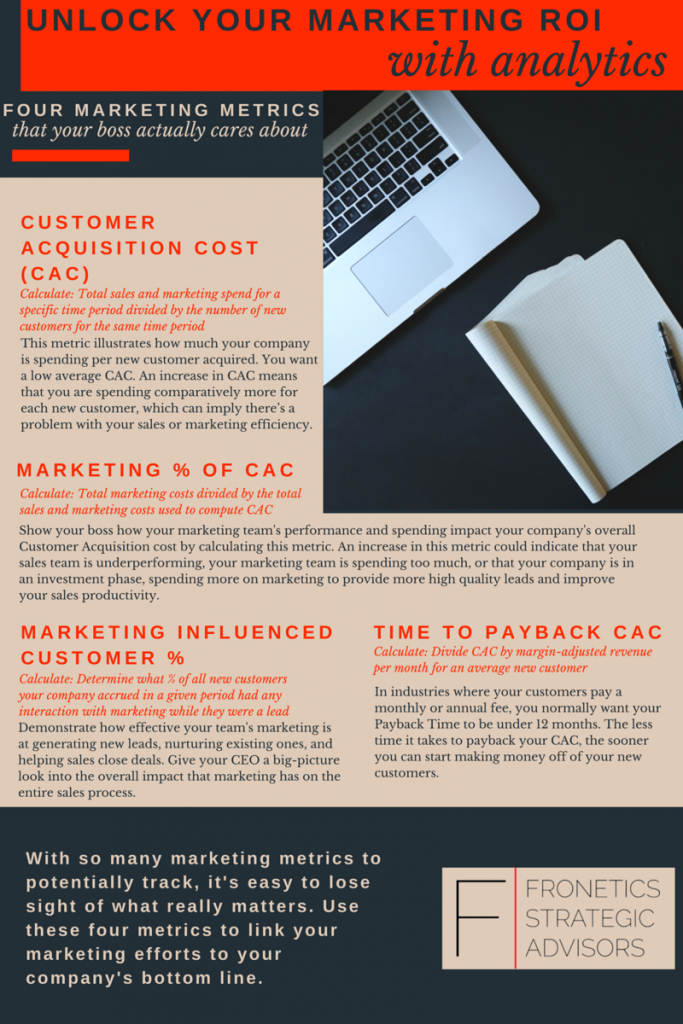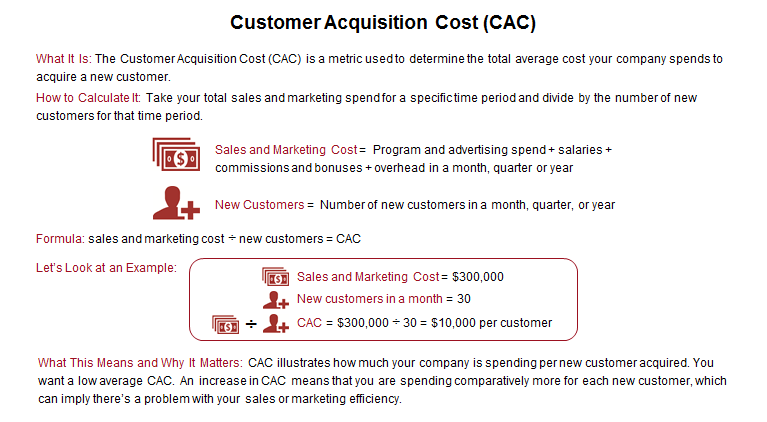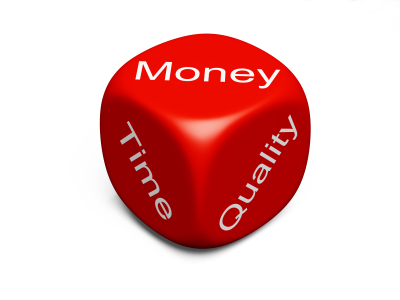
by Fronetics | Mar 30, 2016 | Blog, Marketing

Use these six metrics to communicate the success of your marketing efforts to your boss.
If you are responsible for marketing for your company, you may feel that your tireless efforts are sometimes difficult to quantify to your boss. Much of what we in marketing do is behind the scenes, measured by myriad metrics that demonstrate our strategies are at work. Oftentimes, those metrics do not necessarily speak the same language as our boss.
We are motivated by website visits, conversion rates, generated leads per channel, engagement on social media platforms, blog post shares, email click-through rates, and many other methods that can illustrate the success of today’s marketing campaign. But when you are trying to present the impact of your marketing strategies to your boss, it is hard to demonstrate all of this with measurable results.
You probably sense this, too — a sort of unspoken question mark hanging in the thought bubble over your boss’ head. You share that email click-through rates went up 40%, and there is a blank expression on his or her face. You suspect your boss may not fully appreciate the importance or the overall impact of your work.
And you are probably correct. Bosses theoretically understand that a solid marketing team can directly impact your company’s bottom line, but a whopping 73% of executives don’t believe that marketers are focused enough on results to truly drive incremental customer demand.
Your boss is looking for marketing metrics that matter to him or her, ones that they clearly see a result (or a connection) in customer acquisition or increased sales. This means you must be prepared to report on data that deals with the total cost of marketing, salaries, overhead, revenue, and actual new customer acquisitions.
Six Marketing Metrics Your Boss Wants To Know
There are basically six marketing metrics that your boss is interested in. Here is a brief overview:
- Customer Acquisition Cost (CAC): This is a metric used to determine the average amount your company spends acquiring a new customer. Take what your company spends in marketing costs, divided by the number of new customers it produced. There you have the price of each new customer.
- Marketing Percentage of CAC: This is taking your marketing department costs and dividing it by the total cost of both sales and marketing to determine how much your company is spending on marketing as it relates to the what you spend to acquire new customers. A low marketing percentage of CAC shows that your marketing programs are relatively inexpensive for the results they are producing.
- Ratio of Customer Lifetime Value to CAC: This is an estimate of total value that your company derives from each customer, compared with what you spend to acquire that new customer.
- The Time to Payback CAC: This calculation demonstrates how many months it takes for your company to earn back the CAC it spent acquiring your new customers.
- Marketing-Originated Customer Percentage: This takes all of the new customers from a set time period and examines what percentage of them started with a lead generated by your marketing team.
- The Marketing-Influenced Customer Percentage: This is a metric that highlights all of the new customers that marketing interacted with while they were leads, anytime during the sales process.
When reporting to your boss about the most recent marketing results, it’s crucial to convey your performance in a way in which he or she can quantify the results in terms of impact to the company. Rather than focusing on “soft” metrics like per-post Facebook engagement, use the top six metrics that demonstrate how the marketing efforts led to new customers and what those customers are worth to the company’s growth and success.
For more tips on how to calculate and demonstrate theses metrics, download our cheat sheet on how to show your boss the measurable value of your marketing strategies.
Related posts:
![Unlocking Your Marketing ROI with Analytics [infographic]](https://fronetics.com/wp-content/uploads/2024/10/Fronetics-Marketing-ROI-800x675.png)
by Fronetics | Sep 9, 2015 | Blog, Content Marketing, Data/Analytics, Marketing
In the age of big data, everything in marketing is measureable – and that’s not necessarily a good thing. As Dimitri Maex of Ogilvy Consulting puts it, “marketers are drowning in numbers because they are focused on what they can measure rather on what they should measure.” Unfocused efforts to evaluate the success of your marketing activities can lead to a host of problems. Central to these problems, though, is the failure to measure and report activities in a way that clearly demonstrates the link between marketing and your company’s bottom line. Check out our infographic that details four marketing metrics guaranteed to resonate with your CEO (and our guide to the 6 marketing metics your boss really cares about).

You might also be interested in:
When it comes to marketing we work with our clients to create and execute strategies that drive success and elevate their brand position within the industry. Unlike other firms, we align marketing programs with business objectives and, through a data driven approach, are able to deliver results with a targeted ROI. Our team is comprised of strategists, marketing professionals, writers, designers, and experts in social media. Together we leverage our experience to increase brand awareness, position our clients as thought leaders, drive meaningful engagement with prospects and customers, and help businesses grow.


by Fronetics | Sep 8, 2015 | Blog, Data/Analytics, Marketing
The profile of marketing has definitely been raised lately. With a full 63% of businesses planning to increase their marketing budgets this year, its clear business leaders are looking directly to their marketing departments to drive growth. Along with expanding budgets and more pressure to produce results, marketing metrics are being more heavily scrutinized by executives; marketing departments are being asked to prove the worth of the increased investment in their marketing efforts. And with an enormous amount of potential data to track, marketing can seem more like big data. The good news is it doesn’t have to. Successfully presenting the value of your marketing efforts means showing your boss the metrics that will resonate and prove that you’re moving the needle where it really counts.
Do you know which metrics actually matter to your boss? Rather than talking about per-post Facebook engagement and other “soft” metrics, can you tell your boss, for example, if your company is spending more money this year to acquire new customers than it did last year? Let’s take a look at how you can calculate your company’s Customer Acquisition Cost (CAC) and why your boss actually does care about it.

Reporting on measurements that link your marketing efforts to the company’s bottom line, such as Customer Acquisition Cost (CAC), will put your marketing team in a much better position to make the case for executive support of current and future budgets and strategies. For more metrics that matter, download our guide to The Six Marketing Metrics That Your Boss Actually Cares About. Our 10-page guide lays out the six marketing metrics that will prove the value of your marketing efforts, along with formulas and examples to help you calculate your own metrics and explanations of why your boss finds these metrics so important.


by Fronetics | Feb 23, 2015 | Blog, Content Marketing, Data/Analytics, Marketing, Strategy

Measuring blogging ROI is crucial to your overall marketing success.
Just as with outbound marketing activities, your company’s inbound marketing efforts should be given the same attention when it comes to Return on Investment (ROI) analysis. In fact, companies who measure inbound marketing ROI are more than 12 times more likely to generate better year-over-year returns. And with blogging being reported as the number one method for increasing website traffic, it should stand to reason that calculating ROI for your blogging efforts is crucial to your overall inbound marketing success.
Calculating ROI for blogging activities isn’t as straightforward as say, ROI from click-to-conversion, but its achievements can be measured in other ways. Consider employing a blend of these four categories to measure the effectiveness of your blogging efforts.
Audience and Content Reach
According to a 2013 HubSpot report, 85% of marketers reported increased web traffic within seven months of beginning inbound marketing activities. While it’s true that building a successful blog can take some time, there are things you can do (and measure) to speed its maturity. Encourage engagement and reach by crafting relevant and interesting content for your audience. This increases the likelihood your content is shared and commented on by your readers.
Track this: Beyond noting any increases in web traffic, track both your average cost per view and the number of comments and social shares your blog content receives.
Lead Generation
Tying revenue directly to publishing and distributing blog content can be difficult. Thinking about blogging activities within the context of your entire sales funnel can make it easier to determine effectiveness. As blog content is typically used to attract leads, encourage readers to subscribe to your blog or submit contact info to get higher-value content. Continued engagement nurtures leads and moves them further down the sales funnel.
Track this: The cost to get a lead. You can then determine the percentage of leads that move on to become qualified leads, the percentage of qualified leads that then become opportunities, and the percentage of opportunities that are ultimately won. At the end of the day, you’ll be able to calculate the revenue generated from leads that entered the funnel from blog content.
Intangibles
What are you gaining from networking with industry peers? Has your blog played a role in developing and nurturing professional relationships? Could you consider your blogging activities as part of your professional development? Blogging provides benefits outside of traditional marketing ROI measurements. Time spent researching, networking, writing, and engaging with others in your industry should certainly be considered when determining overall usefulness of blogging.
Track this: Sales cycle times. Staying current with industry trends and building a reputation as the go-to industry expert can be reflected in the type of customers and clients you are attracting. Are you attracting more high-quality leads and closing more ideal customers? Thank your blogging activity.
Cost of Customer Acquisition (CoCA)
By understanding how much it costs your business to acquire a new customer, you gain valuable insight into how much your business should be investing on blogging activities.
Track this: Calculate your (CoCA) by dividing your cost to blog by the number of visits the blog. For example, let’s say your company spent $500 on writing a blog post and 100 people visited your site. Your Cost of Visitor Acquisition will be $5 ($500 divided by 100). If 5% of those blog visitors convert into a lead then your Cost of Lead Acquisition (CoA) is $100 ($500 divided by 5 customers). If 10% of those leads actually buy something from you, your final Cost of Customer Acquisition is $50. Investing in one blog post will yield one new customer for every $50 you invest.
While it can feel a little unwieldy to measure ROI from blogging activities, keeping a strong focus on blogging goals and objectives will help to lend weight to metrics that will ultimately matter the most to you and your business. What measures does your company use to measure ROI for blogging?

by Fronetics | Feb 23, 2015 | Blog, Content Marketing, Data/Analytics, Marketing, Strategy

Measuring blogging ROI is crucial to your overall marketing success.
Just as with outbound marketing activities, your company’s inbound marketing efforts should be given the same attention when it comes to Return on Investment (ROI) analysis. In fact, companies who measure inbound marketing ROI are more than 12 times more likely to generate better year-over-year returns. And with blogging being reported as the number one method for increasing website traffic, it should stand to reason that calculating ROI for your blogging efforts is crucial to your overall inbound marketing success.
Calculating ROI for blogging activities isn’t as straightforward as say, ROI from click-to-conversion, but its achievements can be measured in other ways. Consider employing a blend of these four categories to measure the effectiveness of your blogging efforts.
Audience and Content Reach
According to a 2013 HubSpot report, 85% of marketers reported increased web traffic within seven months of beginning inbound marketing activities. While it’s true that building a successful blog can take some time, there are things you can do (and measure) to speed its maturity. Encourage engagement and reach by crafting relevant and interesting content for your audience. This increases the likelihood your content is shared and commented on by your readers.
Track this: Beyond noting any increases in web traffic, track both your average cost per view and the number of comments and social shares your blog content receives.
Lead Generation
Tying revenue directly to publishing and distributing blog content can be difficult. Thinking about blogging activities within the context of your entire sales funnel can make it easier to determine effectiveness. As blog content is typically used to attract leads, encourage readers to subscribe to your blog or submit contact info to get higher-value content. Continued engagement nurtures leads and moves them further down the sales funnel.
Track this: The cost to get a lead. You can then determine the percentage of leads that move on to become qualified leads, the percentage of qualified leads that then become opportunities, and the percentage of opportunities that are ultimately won. At the end of the day, you’ll be able to calculate the revenue generated from leads that entered the funnel from blog content.
Intangibles
What are you gaining from networking with industry peers? Has your blog played a role in developing and nurturing professional relationships? Could you consider your blogging activities as part of your professional development? Blogging provides benefits outside of traditional marketing ROI measurements. Time spent researching, networking, writing, and engaging with others in your industry should certainly be considered when determining overall usefulness of blogging.
Track this: Sales cycle times. Staying current with industry trends and building a reputation as the go-to industry expert can be reflected in the type of customers and clients you are attracting. Are you attracting more high-quality leads and closing more ideal customers? Thank your blogging activity.
Cost of Customer Acquisition (CoCA)
By understanding how much it costs your business to acquire a new customer, you gain valuable insight into how much your business should be investing on blogging activities.
Track this: Calculate your (CoCA) by dividing your cost to blog by the number of visits the blog. For example, let’s say your company spent $500 on writing a blog post and 100 people visited your site. Your Cost of Visitor Acquisition will be $5 ($500 divided by 100). If 5% of those blog visitors convert into a lead then your Cost of Lead Acquisition (CoA) is $100 ($500 divided by 5 customers). If 10% of those leads actually buy something from you, your final Cost of Customer Acquisition is $50. Investing in one blog post will yield one new customer for every $50 you invest.
While it can feel a little unwieldy to measure ROI from blogging activities, keeping a strong focus on blogging goals and objectives will help to lend weight to metrics that will ultimately matter the most to you and your business. What measures does your company use to measure ROI for blogging?



![Unlocking Your Marketing ROI with Analytics [infographic]](https://fronetics.com/wp-content/uploads/2024/10/Fronetics-Marketing-ROI-800x675.png)




